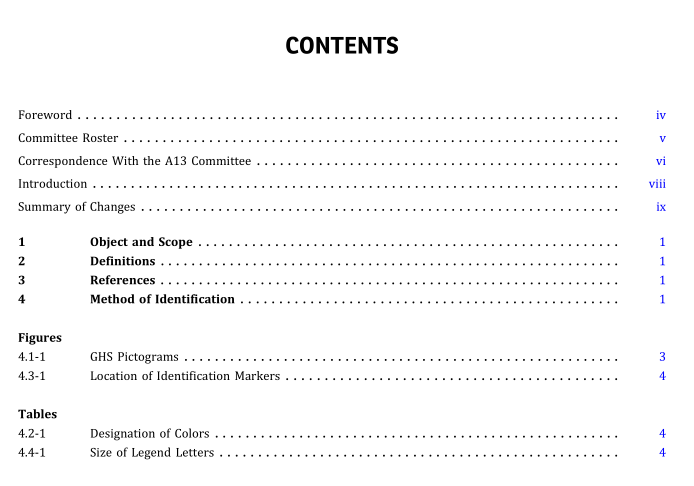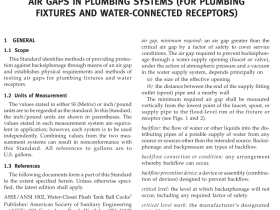ASME A13.1 pdf download

ASME A13.1 pdf download Scheme for the Identification of Piping Systems
1 OBJECT AND scOPE
This Standard is intended to establish a common systemto assist in identification of hazardous materials conveyedin piping systems and the materials” hazards whenreleased in the environment.
This scheme concerns identification of contents ofpiping systems. It is recommended for the identificationof piping systems used in industrial, commercial,and insti-tutional installations, and in buildings used for publicassembly.It does not apply to buried pipelines nor to elec-trical conduits.
Existing schemes for identification shall be consideredas meeting the requirements of this Standard if
(a) such schemes are described in writing
(b) employees are trained as to the operation andhazards of the piping systems
2 DEFINITIONS
combustible: the material classification for fluids that canburn, but that are not flammable.
fire quenching: the material classification including water,foam, and carbon dioxide used in sprinkler systems andfire-fighting piping systems.
flammable: the material classification for fluids that, underambient or expected operating conditions, are a vapor orproduce vapors that can be ignited and continue to burn inair. The term thus may apply, depending on service condi-tions, to fluids defined for other purposes as flammable orcombustible.
oxidizing: the material classification for fluids that may,generally by providing oxygen, cause or contribute tothe combustion of other material more than air does.piping: conduits used to convey, distribute, mix, separate,discharge, meter, control, or snub fluid flows.
piping systems: piping of any kind, including fittings,valves,and pipe coverings. Supports, brackets, or otheraccessories are specifically excluded from applicationsof this Standard.
toxic and corrosive: the material classification for fluidsthat are toxic or corrosive, or that will produce toxicor corrosive substances when released.
3 REFERENCES
The latest edition of the following standards shall, to theextent specified herein, form a part of this Standard.ANSI/NEMA Z535.1,American National Standard forSafety Colors
Publisher: National Electrical Manufacturers Association(NEMA),1300 North 17th Street, Suite 900, Rosslyn, VA22209 (www.nema.org)
GHS,Globally Harmonized System of Classification andLabelling of Chemicals
Publisher: United Nations (UN),405 East 42nd Street, NewYork, NY 10017 (www.un.org)
4 METHOD OF IDENTIFICATION4.1 Legend
This Standard considers a legend to be primary andexplicit for identification of contents. Positive identifica-tion of the contents of a piping system shall be by letteredlegend, giving the name of the contents in full or abbre-viated form. The following are examples of contentdescriptions appearing in a legend:
(a) “HOT WATER”
(b) “SLURRY”
(c) “AIR 100 PSIG”
(d) “ARGON 500 PSIG”
(e) “PROPANE”
“H.P. RETURN”
(g) “HYDRAULIC OIL”
(h) “FOAM”
“CARBON TETRACHLORIDE””CAuSTIC”
(k) “SULFURIC ACID””STEAM 100 PSIG”
Legends shall use arrows to indicate direction of flow.where flow can be in both directions, arrows in both direc-tions shall be displayed. Contents shall be identified by alegend with sufficient additional details, such as tempera-ture and pressure, as are necessary to identify the hazard.Legends shall be brief, informative, pointed, and simplefor greatest effectiveness.Identification may be stenciledor taped on, or marked in ink. In any situation, the number and location of identification markers shall be based on the particular piping system. The applicable GHS 1 pictogram as illustrated in Figure 4.1-1 may be included as part of the legend. Wherepipingisconnectedtocontainersthatarelabeled in accordance with GHS requirements, a corresponding label on the piping may be provided. The corresponding label should contain at least the product name or identi- fier, the pictogram, the signal word, and the physical, health, and environmental hazard statement(s).
4.2 Color Color should be used to identify the characteristic hazards of the contents. Color should be displayed on, or contiguous to, the piping by any physical means, but its use shall be in combination with a legend. Color may be used in continuous, total-length coverage or in intermittent displays. Colors preceded by the word “Safety” shall meet the requirements of ANSI/NEMA Z535.1 (see Table 4.2-1).
4.3 ð20Þ Placement Attention shall be given to the visibility of the pipe markings. Where pipelines are located above or below the normal line of vision, the lettering shall be placed below or above the horizontal centerline of the pipe (see Figure 4.3-1).









